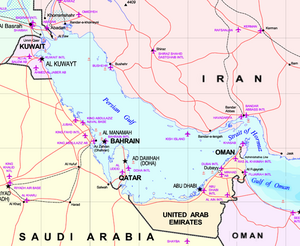Persian Gulf

The Persian Gulf, a major body of water in the Middle East region, is an extension of the Gulf of Oman located between Iran (Persia) and the Arabian Peninsula. Since the 1960s, Persian Gulf Arabs and their states have often referred to the water body as the Arabian Gulf (which is in fact the ancient name of the Red Sea) but this is not commonly used in English and is not acknowledged by organizations such as the United Nations.
This inland sea of some 233,000 km² is connected to the Gulf of Oman in the east by the Strait of Hormuz, and its western end is marked by the major river delta of Arvand/Shatt al-Arab, which carries the waters of the Euphrates and the Tigris. Its length is 989 kilometres separating mainly Iran from Saudi Arabia with the shortest divide of about 56 kilometres in the Strait of Hormuz. The waters are overall very shallow and have a maximum depth of 90 metres, and an average depth of 50 metres.
Countries with a coastline on the Persian Gulf, called the Gulf States or the Persian Gulf States, are (clockwise, from the north): Iran (Persia), United Arab Emirates, Saudi Arabia, Qatar on a peninsula off the Saudi coast, Bahrain on an island, Kuwait and Iraq in the northwest. Various small islands lie within the Persian Gulf.
The oil-rich Arab countries (excluding Iraq) that have a coastline on the Persian Gulf are referred to as the Gulf Arab States. They are the United Arab Emirates, Saudi Arabia, Qatar, Bahrain, Kuwait and Oman.
The Persian Gulf and its coastal areas are the world's largest single source of crude oil and related industries dominate the region.
The Persian Gulf was the focus of the Iraq-Iran War that lasted from 1980 to 1988, with each side attacking the other's oil tankers. In 1991 the Persian Gulf again was the background for what was called the "Persian Gulf War" or "The Gulf War" when Iraq invaded Kuwait and was subsequently pushed back, despite the fact that this conflict was primarily a land conflict.
The natural environment of the Persian Gulf is very rich with good fishing grounds, extensive coral reefs and pearl oysters in abundance, but has become increasingly under pressure due to the heavy industrialisation and in particular the repeated major oil spillages associated with the various recent wars fought in the region.
External links
- The Persian Gulf, Information, history and resources of the Persian Gulf
- The Portuguese in the Arabian peninsula and in the Persian Gulf
- Persian Gulf Region
- Persian Gulf Pavillion of Tehran Int'l Book Fair
- Publication of Historical Maps of the Persian Gulf in Tehran
- Factsheet on on the Legal and Historical Usage of the "Persian Gulf" - ISG MIT
- The Persian Gulf: The Politics of Geographic Renaming
Credits
New World Encyclopedia writers and editors rewrote and completed the Wikipedia article in accordance with New World Encyclopedia standards. This article abides by terms of the Creative Commons CC-by-sa 3.0 License (CC-by-sa), which may be used and disseminated with proper attribution. Credit is due under the terms of this license that can reference both the New World Encyclopedia contributors and the selfless volunteer contributors of the Wikimedia Foundation. To cite this article click here for a list of acceptable citing formats.The history of earlier contributions by wikipedians is accessible to researchers here:
The history of this article since it was imported to New World Encyclopedia:
Note: Some restrictions may apply to use of individual images which are separately licensed.